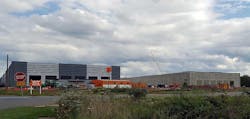Make Way for Data Centers: Demolitions Highlight New Real Estate Calculus
This week's news that Amazon Web Services is demolishing nine buildings in Loudoun County to create a new cloud campus reflects the shifting economics of the digital economy. As more business moves online, the Internet will need more real estate.
And because data centers are a latency-sensitive business, proximity matters. This has begun changing the real estate math in leading technology corridors.
We first wrote about this phenomenon in DCF's "8 Trends" Forecast for 2020:
"As data tonnage reinforces the importance of proximity, we’ll see more 'knock-down' expansion projects, as developers buy adjacent properties and demolish existing buildings to create new data center campuses. In major cloud corridors, economics will make data centers the most valuable use for real estate."
Amazon's Plans in Sterling
That can clearly be seen in Amazon's plans to create more cloud capacity in Sterling, which is just east of Data Center Alley in Ashburn. AWS plans to demolish 9 buildings on Nokes Boulevard, Manekin Plaza and Ridgetop Circle in Sterling and replace them with four purpose -built data centers providing more than 900,000 square feet of data center space. The news was initially reported by the Washington Business Journal.
The project will expand a growing cloud cluster surrounding the Dulles Town Center mall, which includes multiple data centers for CyrusOne, EdgeCore Digital Infrastructure and Cyxtera Technologies.
"AWS data centers bring job creation, investment, and educational programs that are benefitting communities across the United States," said an AWS spokesperson. "Since 2006, AWS has invested more than $35 billion in Virginia, and has supported thousands of highly skilled jobs and helped grow the GDP of the Commonwealth by billions of dollars in that time. We are proud of the ways we benefit our communities and look forward to helping the continued growth in Sterling."
The demolitions in Sterling are the latest examples of a trend that has its genesis in Santa Clara, where data center developers have for many years purchased properties with existing buildings and then knocked them down to create a data center campus. It's a strategy driven by the lack of vacant land in Santa Clara, which historically has offered competitive power pricing from the municipal utility, Silicon Valley Power. That’s why there’s 35 data centers are located in an 18-square mile municipality.
It's an expensive strategy, as parcels with existing buildings in Santa Clara have sold for $7 million an acre or more. Those deals reflect the extraordinary value of data center real estate, which has had a transformative impact on real estate in Northern Virginia in recent years.
Shifting Real Estate Values
Demand for cloud capacity in Northern Virginia has pushed land values for data center parcels past $3 million an acre, up from about $500,00 as recently as 2017.
“Loudoun land is the most sought-after asset for this industry,” said Buddy Rizer, the Executive Director of Economic Development for Loudoun County.
There are a number of examples of projects in the Ashburn market where developers are demolishing existing buildings to create new data centers. The most high-profile one is the former AOL headquarters complex in Ashburn, which is being knocked down to make way for a data center campus for PowerHouse Data Centers, which is expected to be completed in late 2025.
Then there's Data Center Alley itself, where several sites around the Equinix campus in Ashburn feature projects where a building has been demolished to clear the path for a new data center:
- Digital Realty plans to create its 40-megawatt Digital Filigree data center on property adjacent to the Equinix main campus, knocking down an existing building.
- Cologix is creating a data center campus next to Equinix on the former site of the Christian Fellowship Church on Beaumeade Circle.
- Further up Beaumeade Circle, PowerHouse has just leased an entire purpose-built data center that is scheduled to be completed this fall on a site that once housed which housed the operations of tech contractor Intelligent Decisions.
The trend has also popped up in Los Angeles, where Digital Realty has filed plans to demolish an existing parking garage to make way for a 13-spory data center.
The flip side of these projects is that they come with a longer timeline, as developers must factor in the time and approvals needed to demolish the existing site. That's why knock-down developments tend to be part of the long-term planning process.







